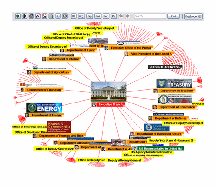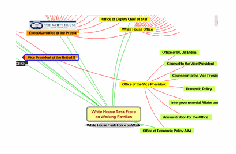Virtual Reorganization:
How to Create Smarter, Better, Faster Organizations without Moving the Boxes Around
Done well, virtual reorganization is a low-cost, high-yield performance improvement strategy.
Good organization designs offer largely untapped resources for productivity in big hierarchies and bureaucracies. The right structures can be keys to unlocking performance potential trapped in the wrong ones. Poor organization carries great risks: it can lead to poor results, the inability to adapt to change, chronic proneness to instability, and, in some cases, complete collapse.
At a time when the web is nearly ubiquitous—as is information technology in general—organizations have the capacity to reorganize in ways that lead to their being collectively smarter, better, and faster. Such capacities are critical in meeting challenges and seizing opportunities in the tumult of change.
The collapse of so many institutions at the same time screams out for reorganization, now unavoidable and now underway in all sectors. But before you whip out your organization chart and start crossing off boxes or stripping out layers, you would be well advised to remember this: simplistic reorganization often makes things worse.
We propose four interrelated actions, each with its own benefits that lead to smarter and more sustainable reorganization:
-
1st, visualize in order to see the whole organization as it is and how it might be;
-
2nd, analyze the organization’s positions to identify “hotspots” and reveal unexpected patterns ingrained in the system;
-
3rd, apply principles to better fit the organization’s purpose and hierarchy’s need to both communicate faster and make more complex decisions; and
-
4th, reorganize virtually, by quickly and intelligently drawing lines where none existed before, reorganizing physically only where necessary
Visualize the Digital Org Chart
To start the process of smart reorganization, first the enterprise needs an accurate picture of itself. Ask anyone in an organization for its org chart and typically you’re handed a piece of paper—or sent to a website—with a box-and-wire diagram showing a few dozen positions. Whether the organization in question has fifty employees or 50,000, the charts generally look the same—and the request for one rarely, if ever, produces an accurate map of the whole thing.
 What
this means is that the vast majority of people in control are
running organizations whose true size, shape, and structure they
never really see. Thus, the initial act is to create and maintain an
accurate digitized organization chart that represents the entire
reporting structure, one that is visible, navigable, and analyzable
(see live
example). With such a chart in hand, the organization
then can:
What
this means is that the vast majority of people in control are
running organizations whose true size, shape, and structure they
never really see. Thus, the initial act is to create and maintain an
accurate digitized organization chart that represents the entire
reporting structure, one that is visible, navigable, and analyzable
(see live
example). With such a chart in hand, the organization
then can:
-
Publish public versions to the web so that anyone can access the map, leading to improved transparency, trust, and cross-organization collaboration;
-
Overlay reporting relationships with additional matrix, team, process, and information connections that intersect positions regardless of who holds them, making for more cohesive, better “networked” organizations and providing greater insight into the complexity of each job;
-
Attach missions, goals, and budgets to each organizational unit, making purposes and resource allocations visible; and
-
Link public data related to each position, including physical location, wiki pages, websites, physical and virtual contact information.
Analyze the Organization as a Network
-
Better match people to the requirements of each position and understand its impact on the organization as a whole;
-
Design internal communication strategies that allow leaders to reach everyone very quickly with key messages and information, thus avoiding the traditional communication cascade that is prone to message distortion;
-
Craft individual development plans that reflect people’s true leadership responsibilities;
-
Allocate HR and IT resources to support those with the greatest need and potential to contribute to overall organizational improvement;
 Simultaneously,
analyze the map of the organization’s reporting structure
using simple tools from network management science. Even rudimentary
analysis allows an organization to quickly determine the management
load of each position, pinpointing which jobs have the most
potential for performance improvement and which are at greatest risk
for burnout. With these results in hand, management is then in a
position to:
Simultaneously,
analyze the map of the organization’s reporting structure
using simple tools from network management science. Even rudimentary
analysis allows an organization to quickly determine the management
load of each position, pinpointing which jobs have the most
potential for performance improvement and which are at greatest risk
for burnout. With these results in hand, management is then in a
position to:
Organizing at the Edge of Chaos
Organizational configuration data and metrics help guide the specifics of reorganization, but principles are needed to guide the more general transformation of networked hierarchies now underway. In particular, it is critical to understand whether “flatter is better” as a reorganization prescription. Often, it’s not.
An organization seeks to minimize communication pathways while maximizing its capacity for complex decision-making.
These contrasting tendencies drive efforts to both centralize and decentralize.
-
As they seek to optimize communication, organizations tend to centralize. The bigger the span, the fewer the levels, the shorter the communication paths.
-
To cope with complex decision-making, organizations tend to decentralize. The smaller the span, the greater the number of levels, the greater the capacity to make decisions.
In simplest terms: to communicate, flatten the structure—reduce the number of levels—and enlarge the size of the teams. To make better decisions, deepen the structure—increase the number of levels—and make the teams smaller. In the coming world, organizations will morph as needed to accommodate the pressing needs of the moment.
How to Reorganize Virtually
From the beginning of the mapping process, the development of org charts at all levels itself engages discussion about the purposes, roles, relationships that touch each executive, supervisory, and staff position along with their associated organizations. In many cases, this will naturally catalyze local improvements and sets the stage for cross-organizational reorganization using both physical and virtual strategies. The virtual approaches are:
-
Strategy One: Implement e-Government, Externally and Internally
-
Strategy Two: Institute Coordinating Councils and Communities of Practice
-
Strategy Three: Stimulate Collaboration with Virtual Teams of Leaders

-
Develop issue-based coordination councils and task forces that connect the fixed positional boxes in new configurations to meet reorganization goals;
-
Support cross-organizational collaboration with virtual teams of leaders and make the network of teams visible for better end-to-end results;
-
Experiment with different designs to see how the analytic metrics affect communication and decision-making;
-
Grow communities of practice to engage the wisdom and leadership of everyone in the organization; and
-
Use the “reorganized” and enriched map to help people understand the changes and gain a view of the organization as a whole, thus enabling them to make better local decisions that fit the global purpose.
With these strategies, organizations can:
The full Virtual Reorganization report is available in PDF here.
These NetAge Reports are online and available in PDF:
You can run The US Gov Map dynamically run in your browser.

